60 years of Caritas Australia
Caritas means love and compassion in Latin and these two powerful words have guided us for the past 60 years, as we worked hand-in-hand with our partners worldwide to make a difference in the lives of those who need it most.

Thandolwayo collecting water in Zimbabwe. Photo credit: Richard Wainwright/Caritas Australia.

60 Faces: Portraits of Compassion in Action
60 Faces: Portraits of Compassion in Action tells the story of Caritas Australia’s impact across the world through 60 hand-picked photographs of participants from our international and Australian programs. The 60 faces represent all we achieved together in the last 60 years, supporting vulnerable communities to confront the challenges of poverty and build a thriving future.
Caritas Australia 60th Anniversary Virtual Gallery
We have compiled a selection of our favourite 60 photos in this virtual gallery below. These 60 faces represent all we achieved together in the last 60 years, supporting vulnerable communities to confront the challenges of poverty and build a thriving future.













